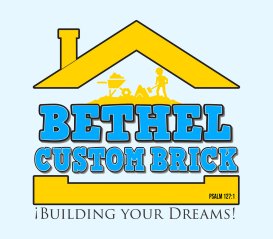A brick chimney is a striking and functional feature of many homes, but over time, cracks can develop, compromising both its structural integrity and appearance. Understanding the common causes of chimney cracks and knowing how to address them is key to maintaining a safe and long-lasting chimney. Here’s an in-depth look at why cracks occur in brick chimneys and the best methods for fixing them.
Common Causes of Cracks in Brick Chimneys
1. Thermal Expansion and Contraction
What Happens:
Brick and mortar expand and contract with temperature changes. Over time, this repeated movement can cause stress, leading to cracks in the chimney structure.
Common Signs:
Vertical or stair-step cracks in the bricks or mortar joints.
Prevention:
Regular maintenance and sealing can help protect the masonry from extreme temperature fluctuations.
2. Water Infiltration
What Happens:
Water penetrates the brick and mortar, freezes in colder months, and expands, causing cracks to form. This process, known as freeze-thaw cycling, is a common cause of spalling bricks.
Common Signs:
Crumbling bricks, deteriorated mortar, and white stains (efflorescence) on the chimney surface.
Prevention:
Waterproofing your chimney and ensuring the crown and cap are intact can minimize water damage.
3. Foundation Shifts or Settling
What Happens:
Over time, the foundation of your home or chimney can settle or shift due to soil movement, poor drainage, or nearby construction. These shifts put stress on the chimney structure, resulting in cracks.
Common Signs:
Large, diagonal cracks or a leaning chimney.
Prevention:
Proper drainage and regular inspections can help identify and mitigate foundational issues before they cause damage.
4. Chimney Crown Damage
What Happens:
The chimney crown is the protective top layer that prevents water from entering the chimney. When it becomes cracked or deteriorated, water seeps in, causing damage to the bricks and mortar below.
Common Signs:
Cracks in the crown itself or water damage on the bricks just below the crown.
Prevention:
Inspect and repair the chimney crown regularly to maintain its protective function.
5. Poor Construction or Repairs
What Happens:
Subpar materials or improper installation can lead to premature wear and cracks. Similarly, poorly executed repairs can fail to address the underlying issues, exacerbating the damage.
Common Signs:
Cracks that appear soon after installation or repairs.
Prevention:
Hiring experienced professionals for installation and repairs ensures high-quality results.
6. Lack of Maintenance
What Happens:
Neglecting routine inspections and maintenance allows small issues to escalate into larger cracks and structural damage.
Common Signs:
Widespread cracks, loose bricks, or deteriorated mortar joints.
Prevention:
Regular chimney inspections and timely repairs keep the structure in good condition.
7. Chimney Settlement or Leaning
What Happens:
If the chimney's foundation is not adequately supported or begins to erode, the structure may lean or settle unevenly, leading to large cracks.
Common Signs:
Visible leaning or gaps in the mortar joints.
Prevention:
Addressing drainage and soil stability around the chimney base can reduce the risk of settlement.
How to Fix Cracks in Brick Chimneys
1. Repointing Mortar Joints
The Process:
Damaged or missing mortar is removed and replaced with fresh mortar to restore stability and seal cracks in the joints.
Best For:
Small to moderate cracks in the mortar joints.
Benefits:
Strengthens the chimney and prevents further water infiltration.
2. Repairing or Replacing Cracked Bricks
The Process:
Cracked or spalled bricks are removed and replaced with new, matching bricks. In some cases, epoxy fillers can be used for minor brick repairs.
Best For:
Isolated cracks or damaged bricks.
Benefits:
Restores the appearance and structural integrity of the chimney.
3. Sealing the Chimney
The Process:
A waterproof sealant is applied to the entire chimney surface to protect against moisture and freeze-thaw damage.
Best For:
Chimneys with minor surface cracks or those prone to water damage.
Benefits:
Prolongs the life of the chimney by preventing further cracking.
4. Crown Repairs
The Process:
Cracks in the chimney crown are filled with a masonry-compatible sealant or, if the damage is extensive, the crown is replaced entirely.
Best For:
Chimneys with damaged crowns and associated water infiltration.
Benefits:
Prevents water from entering the chimney and causing further damage.
5. Foundation Repair
The Process:
Addressing foundation issues may involve installing piers, improving drainage, or stabilizing the soil beneath the chimney.
Best For:
Chimneys with large cracks or visible leaning due to foundation problems.
Benefits:
Ensures long-term stability and prevents future cracks.
6. Full Chimney Rebuild
The Process:
If the chimney has extensive damage or is structurally unsound, rebuilding it from the foundation up may be necessary.
Best For:
Severely compromised chimneys with widespread cracks or leaning.
Benefits:
Creates a safe, durable, and visually appealing structure.
Proactive Maintenance Tips to Avoid Chimney Cracks
- Schedule annual chimney inspections to catch small issues early.
- Apply waterproofing treatments to protect the masonry from moisture.
- Regularly clean your chimney to remove debris and prevent blockages.
- Repair small cracks as soon as they appear to prevent further deterioration.
Bethel Custom Brick – Expert Chimney Repairs in the Detroit Metro Area
At Bethel Custom Brick, we specialize in repairing and restoring masonry chimneys to ensure they are safe, functional, and beautiful. Serving the Detroit Metro area, our team of skilled professionals addresses cracks, water damage, and structural issues with expert craftsmanship. Contact us today to schedule an inspection and let us restore your chimney to its former glory.


